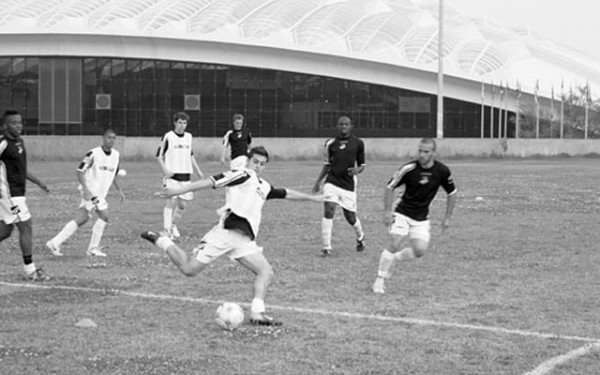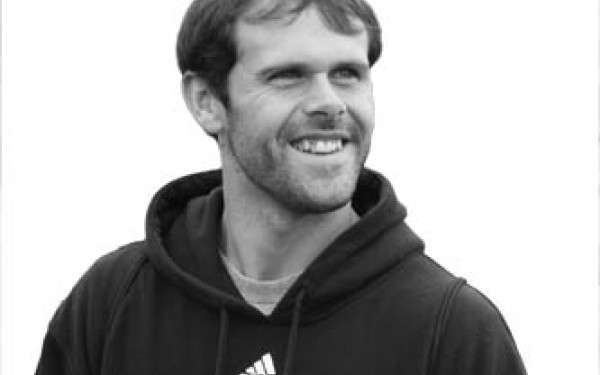Scissor Kick
Debunking the NCAA-CIS Soccer Gap
Nothing sums up American soccer better than a crowd of 25,000 rowdy college fans taunting the opposing goalkeeper with a chant of, “Hit the weight room, skinny.”
It’s a scene from Red Bull Arena, home of the New York Red Bulls of Major League Soccer, which opened its doors to the National Collegiate Athletic Association’s Big East tournament this year, where the University of Connecticut played St. John’s University for the conference title Sunday afternoon on national television.
The last game to be played at the stadium before the tournament was an MLS semi-final starring French star Thierry Henry and none other than Mr. Posh Spice himself, David Beckham.
Red Bull Arena features an interactive press box, customized university pressroom décor and two massive jumbotrons—the pitch even has scrolling team advertisements around it, like richer, successful European professional clubs have.
It’s a stark contrast to what’s happening on the other side of the continent, at the Canadian Interuniversity Sport championships, hosted at the University of Victoria’s Centennial Stadium.
The pitch in Victoria is lauded as one of the best in the land, but a lone grandstand the size of Loyola Campus’s sits behind a racetrack. No ads, no fancy décor, and no big screens. The biggest match played at this stadium might have been in 1994 when the Commonwealth Games were held in British Columbia’s capital.
In comparison, the Big East Championship isn’t even the most coveted trophy in NCAA competition. So one can’t help but wonder which league, and country, takes soccer more seriously—the NCAA or the CIS?
Head of the Canadian Coaches’ Association Patrick Nearing thinks there is a widespread assumption that there’s a big gap between the talent on the CIS pitches and the NCAA’s.
He believes the two leagues are on par in that regard, however, and notes that Canadians even have it better when it comes to education and healthcare, the difference being the U.S. has money to glamorize the sport, making it seem like it’s the best option in university sport.
“The quality of the players, in my opinion, is equal. But for the quality in education, people stay in [Canada],” said Nearing. “The spectacle that’s put on by Division One [NCAA] athletes, the money involved, the facilities, the way the universities are branded in terms of athletic excellence, I still think there is quite a big gap.”
One example of the spectacle Nearing was referring to is the NCAA Super Draft—a selection of the top graduating players from NCAA to the professional North American league, the MLS. This only happens in the NCAA, and as of now, there is no draft option for graduating players from CIS to a professional team.
During the Super Draft, which is televised on ESPN, families and friends of the best in NCAA soccer are invited to watch their graduating loved ones walk across a stage fit for the Oscars once their name is called by managers and owners of a MLS team.
This kind of show is definitely not put on by Canadian universities. Money isn’t poured into student scholarships like the NCAA, where plentiful scholarships are available, and recruiting from other countries is made virtually impossible due to inflated international student rates demanded by Canadian universities.
“The NCAA has probably more depth of players in quality because of international students,” admits Nearing. However, he thinks this might not be such a bad thing.
“I don’t know if we actually would want to bridge that particular gap. I know a lot of the programs all over Canada are student-first athletes.”
Nearing, who is also the head coach of the University of Dalhousie men’s soccer team, wants student-athletes to be successful in life after university, and not be stuck when their dreams of pro stardom don’t materialize.
“Kids who actually get drafted, like, from St. Pats, 10th overall, none of those players are going to stick [in the MLS],” said Nearing.
He says they might bounce around in the squad for a while, but won’t have much of a shot with the grade of other talent being tempted into the MLS from other professional leagues around the world. And when throwaway players eventually get cut from the team, they might not have a decent enough degree to fall back on.
However all the free healthcare, quality education, and Tim Horton’s couldn’t keep University of Connecticut forward Allando Matheson in Canada.
The Canadian freshman said he had to one day move onto fulfill his dreams of playing professionally. Matheson moved to Ontario at a young age and was a late bloomer—he only started to play soccer at age 15. But he had to go south to compete at the highest levels, he says—something that wasn’t available to him in Canada.
“Canada didn’t really provide me with the option to go to school and play [soccer]. So it’s the best I can do for myself.”
–Allando Matheson, University of Connecticut forward
“The move to NCAA was definitely beneficial,” said Matheson after losing in extra time in the finals at Red Bull Arena. “Canada didn’t really provide me with the option to go to school and play [soccer]. So it’s the best I can do for myself.”
Players aren’t the only ones jumping ship from Canada either. Simon Fraser University in Burnaby, B.C. is currently in the NCAA Division Two from CIS, the first non-U.S. post-secondary to join the league.
They did so to “challenge our students and student athletes to be the best,” according to former SFU athletics director Lorne Davies.
Moreover, other major Canadian talents have migrated south to compete at a higher level, and have now made it big—the most-known case being Owen Hargreaves.
Hargreaves was born in Edmonton, but moved to the soccer promised land of Germany at age 16.
He now plays for the top team in England, Manchester City, and has played internationally for England, as his English-born parents qualify him to play, thus not being eligible to play for Canada. He was even voted the best English player in the 2006 World Cup.
And there is still undeniable skill coming from, and then out of, Canada. Associate head coach of the UConn Huskies Tim O’Donohue always shops around up north—there are currently three Canadians on his squad, including Matheson, and O’Donohue says he’s looking for more.
In fact, when asked about the CIS, Matheson couldn’t even say what it was.
“We’re aware of the [CIS]. We go up for a couple showcases there, and we have a couple contacts there to look at their players,” said O’Donohue. “We’ve got some excellent players from Canada.”
He even suggested two of his players might have a shot at going pro, particularly Matheson.
“I think they have bright futures. [Matheson] is one of the top freshmen in the country, so he’s got a bright future here,” said O’Donohue.
As for international play, Matheson was born in Jamaica and can still choose to opt out of playing for Canada in favour of the Caribbean nation, which is ranked 33 places higher in FIFA’s men’s world rankings.
Nearing is well aware of this soccer brain drain. In order to maintain his claims that CIS soccer is on par with NCAA, a clear route to the pros has to be made for Canadian talent to keep them in the Canadian system until they graduate.
According to him, a plan may be in the works with the United Soccer Leagues—a collection of associations of varying degrees of talent that was home to the Vancouver Whitecaps and Montreal Impact before their jump to the MLS.
“We’re working on floating ideas informally on how we can get to step one of getting some spots in the USL combine, so that our top CIS student athletes might get an invite.”
In the USL, players can grow in a professional environment to become better, according to Nearing. But this isn’t the only option. Getting ‘seen’ and getting a trial is easier for more serious soccer players motivated to make it, now that three top-tier soccer teams—the Impact, the Whitecaps, and Toronto FC—are established in Canada.
It’s not clear how many Canadians have gone this direction as of yet, but Nearing is confident it’s just another route to make it pro. MLS has even has a rule stating Canadian teams must have at least three Canadian players on the team, and scouts won’t have to go far to find competitive Canadian talent.
“It was never like this 10 years ago,” said Nearing. “It was—someone gets a break and makes it in Europe.
“Now they’re looking for opportunities in MLS […] there’s ambition in coaches and playing rank, and there’s a pathway people can see that is fuelling the ambition of MLS and USL.”
There’s no official ranking that compares both leagues, but for the near future the NCAA will continue to focus on hitting weight rooms and dazzling spectators in the offseason, and Canada will focus on their student-first method of education.
But with the sport growing in popularity up north, perhaps CIS and its universities might have to dip into their pockets to ensure the show does go on here, too.

1_900_600_90.jpg)
2_900_600_90.jpg)
2_900_600_90.jpg)
_600_832_s.png)




